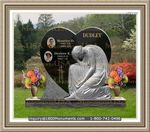|
Basics You Should Learn When Creating A Memorial Epitaph
Setting up funeral arrangements is a job that entails a long list of details. These are usually left to a responsible member of the deceased's family or various tasks may be assigned to several individuals for less stress on one mourner. A key part of this duty is composing an epitaph worthy of the person it will represent.
This is the information that is inscribed on the gravestone, or commemorative plaque, of one who has passed away. The main purpose for it is to tell visitors a little something about the person interred on that spot. This tribute can be created in numerous different styles all depending on the author and the personality of the honoree.
Nearly every grave marker starts out with the same basic identifying information. They state with the deceased's name and the date of their birth followed by when they passed away. Some people choose to stop there, but many opt to include additional statements, sentiments or facts that either describe the individual, or speak to their life or personality.
Traditionally, these inscriptions are short, touching sentiments stating what the individual meant to those who loved them or wishing them a peaceful rest. Sometimes they attest to what a loving spouse, parent, child or sibling they were, or mention their time in military service. Another popular choice is to use their favorite religious scripture.
A lot of people are choosing to design their own headstone. The primary benefit to this is that they can be sure that their last impression will be one they are comfortable leaving. It allows a bit of freedom, for example, for a person who was known for their sense of humor to be entertaining and witty with their final remarks.
Those who write their own might also like to use this as a platform to impart a last bit of wise advice to others. Often this involves encouraging people to be happy and live life well. One can be as creative as they wish with their final statement.
|
|



























